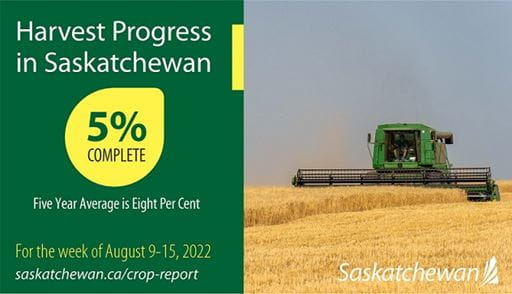Released on August 18, 2022
Producers made the most of the hot dry weather by harvesting as much as possible before thunder and rainstorms rolled through the province on the weekend, and harvest progress is now sitting at five per cent, just behind the five-year average (2017-2021) of eight per cent.
The southwest is leading harvest with 17 per cent of their crop now in the bin, followed by the west-central with eight per cent. Some producers in the southeast have begun harvesting earlier seeded crops that matured and they now have two percent of their crop in the bin. The East central region has one per cent of their crop harvested and the northern regions have not yet started harvest operations on a large scale. Producers in the southwest and west-central are reporting that they are seeing yields well below average.
Thirty-six per cent of the winter wheat, 22 per cent of the fall rye, 16 per cent of the field peas, 24 per cent of the lentils and two per cent of canola has been combined. Many fields have been swathed and are close to being ready to be combined.
There was precipitation in every region this past week with multiple storms bringing rain, hail and wind. The most rain received this week was in the Humboldt area where one crop reporter recorded 83 mm. The Broadview area received 65 mm, the Vanguard area 30 mm, the Saltcoats area 49 mm and the Conquest and Dinsmore areas received between 1 mm to 6 mm. Many producers in Crop District 6B (the Saskatoon-Outlook region) have received less than 150 mm (six inches) of rain this growing season and their crops, pastures and hay land have been impacted similarly to last year. There are water shortages across the southwest and west-central, resulting in many producers hauling water and continually testing the water quality of dugouts used for livestock.

Rain is now too late for annual crops in the driest areas of the province, although it could benefit cattle by increasing the amount of available drinking water and allowing pastures some relief from the hot dry weather. Cropland topsoil moisture across the province is rated as three per cent surplus, 60 per cent adequate, 24 per cent short and 13 per cent very short. Hay and pasture land topsoil moisture is rated as two per cent surplus, 58 per cent adequate, 24 per cent short and 16 per cent very short.
Crop damage causes this week were attributed to insects such as aphids, diamondback moths and grasshoppers, strong winds, heavy rains and hail. There were several reports across the province concerning hail damage; some crops only received minor damage and are expected to recover while others were completely cut down. Grasshoppers have caused significant crop damage all season, and producers who are now harvesting, report they are dealing with plugged equipment from harvesting fields infested with this pest which creates delays and will require them to clean their seed.
Farmers are busy getting equipment and bins ready for harvest, swathing and desiccating crops, and combining where crops are ready. Other producers are waiting for their crops to mature.
With harvest underway in Saskatchewan, producers and the public are reminded to exercise caution regarding machinery and equipment moving on major and secondary highways. Concern about fires is very high and farmers should ensure firefighting equipment is properly maintained and close by to stop any combine or field fires from getting out of control.
A complete, printable version of the Crop Report is available at Download Crop Report.
Follow the 2022 Crop Report on Twitter at @SKAgriculture.
-30-
For more information, contact:
Matthew Struthers
Agriculture
Phone: 306-694-3714
Email: matt.struthers@gov.sk.ca

